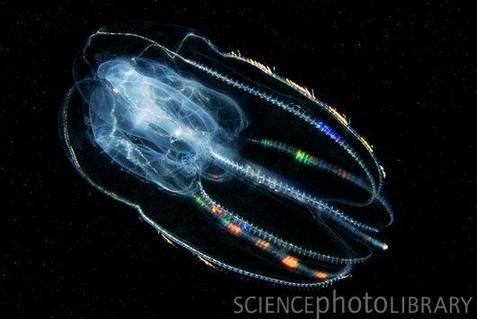Dear Biology Nerd,
I loved learning about stomatopods – can I get some more mysterious creatures, please? Maybe less freaky-looking?
-Anna S.
***
Dear Anna,
Since my discussion of stomatopods seems to have touched off a surprising boost in their popularity across the internet (including a piece by my beloved Oatmeal… coincidence? Probably), I’m going to use my powers for good and give you new crazy-awesome invertebrates to ogle: ctenophores! I’ve always called them “teen-o-fours,” but now the internet is telling me that “ten-o-fours” is also acceptable. These guys are the comb jellies, and no, they have absolutely nothing to do with hair products… I hope.
Instead, the name “comb jellies” comes from the cilia along the edges of their body. Cilia are tiny tube-like bristles used for movement and to increase the critter’s surface area (so it can absorb more food from the water). Increasing the surface area makes it possible for the jellies to sweep more water, which makes it possible to move even faster. Ctenophores move them in wavelike patterns to wiggle their way through the oceans. Imagine running a fingernail down a hair comb and gently bending back each tooth. The comb jellies do this with their row of cilia to move the water back along their body and propel themselves forward. Comb jellies are the largest animals known to use cilia for movement, but even so most of them max out at a few centimeters.
Now comb jellies may look a bit like your standard jelly fish, but they are actually in completely different phyla.* Unlike most jellyfish, comb jellies cannot sting (okay, one species can, out of the 300 known). They lack the special cells called nematocysts found on a jellyfish’s tentacles. So you can play with these little guys without being stung. And you’ll want to, because they’re preeeeeetty.
Almost all comb jellies are bioluminescent — they use chemicals in their bodies to make light. The most common colors are blue, green, or red. Their bioluminescence is triggered by being in the dark, so if you shine a light on a ctenophore, it will turn itself off within thirty minutes. Even better, the jellies beat their cilia in little waves, which scatters their light and creates tiny rainbows.
So there you go: tiny, pretty, pokable, rainbow creatures. Wanna watch ‘em float around?
http://www.youtube.com/watch?v=G7WT81ukHZE
http://www.youtube.com/watch?v=IUC375J9bqQ
And if The Oatmeal suddenly feels a need to make an infographic about ctenophores… well, it’ll probably still be coincidence. But I can take credit for it in my mind!
Yours,
The Biology Nerd
* A phylum is one of the technical names for a group of plants, animals, etc. There is a hierarchy that goes kingdom (examples are animal, plants, fungi), and then phyla (echinoderm, vertebrates, hexapoda which has all of your insects and so on). The groups gather together animals based on shared characteristics and get smaller and smaller until they only contain one animal.
Got a biology question? Ask the Biology Nerd! asktheleagueofnerds@gmail.com
Or: Twitter @AskTheLeague / facebook.com/asktheleagueofnerds
References:
http://faculty.washington.edu/cemills/Ctenophores.html
http://www.hbwbiology.net/taxonomy-ctenophora.htm
http://jellieszone.com/ctenophores.htm
and of course http://en.wikipedia.org/wiki/Ctenophora
